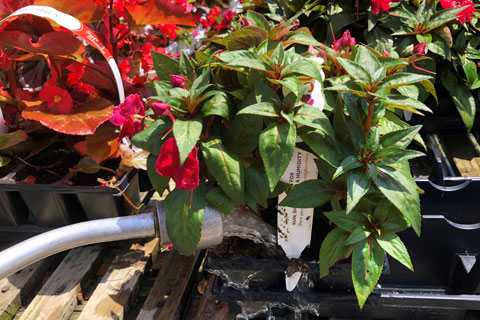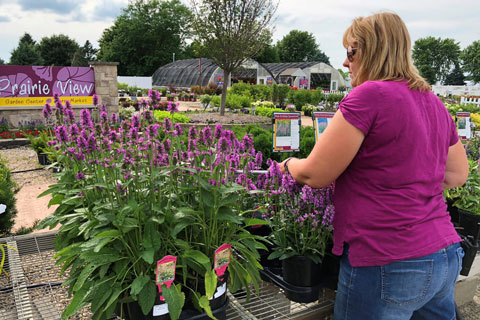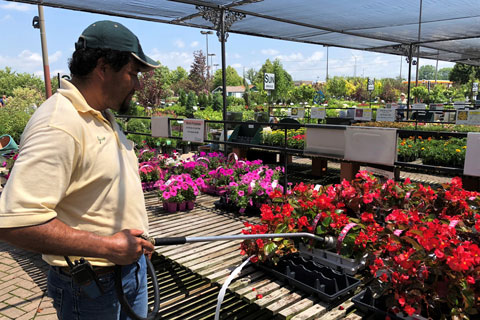8/1/2018
Hydration for Healthy Plants
Diana Stoll
 All living things are made up mostly of water. The human body is typically 60% to 70% water, but in plants this proportion skyrockets to 90%. It’s no wonder water is so important to plants and nowhere is this more apparent than in garden centers.
All living things are made up mostly of water. The human body is typically 60% to 70% water, but in plants this proportion skyrockets to 90%. It’s no wonder water is so important to plants and nowhere is this more apparent than in garden centers.
As water travels through plants from root systems up through stems, leaves and into flowers, it’s vital for photosynthesis, transpiration, transporting nutrients and maintaining the structure of annuals and perennials by keeping cells turgid.
Pictured: Applying water directly to the soil is the best method for ensuring healthy plants at retail.
Maintaining plants is what customers believe independent garden centers do best. They count on staff to be more knowledgeable and expect the plants to be in tip-top condition all summer long, regardless of the weather.
Watering is the most important way garden centers care for their plants and it may sound simple, but it’s not. In a perfect garden center in a perfect world, all the plants receive the correct amount of water at the correct times. But in the real world of multi-tasking and seasonal staff, garden centers end up dumping cartloads of plants due to under-watering or over-watering.
An Eye on the Plants
Plants give warning signals when their water needs aren’t met. Under-watered plants may wilt because water-depleted cells lose turgidity.
“Lower leaves may turn yellow, and leaf tips and leaf margins may scorch, as they are the first to suffer from water loss,” says James Theuri, Extension Educator with University of Illinois Extension.
 Over-watering plants is just as harmful. Over-watered plants are unable to take up nutrients, resulting in poor growth. Stems may wilt and flowers and leaves at the top of the plant may die.
Over-watering plants is just as harmful. Over-watered plants are unable to take up nutrients, resulting in poor growth. Stems may wilt and flowers and leaves at the top of the plant may die.
“Because of the stress caused by too much water in roots, fungal infections may occur,” James warns.
Pictured: Cheryl Linnemann, co-owner of Prairie View Garden Center & Farm Market in Hampshire, Illinois, only allows a senior staff person or herself to train new waterers to ensure it’s done properly.
Another complication to proper watering, not all plants require the same amount of water to thrive. Some plants have developed characteristics to exist in drier growing conditions. Plants with fleshy, fuzzy or silver foliage often prefer drier conditions than other plants.
Additional factors influence the amount of water plants require—the size of the plant in the pot, the soil mix and weather conditions. On a hot, sunny and windy day, some plants are likely to require watering at least twice.
Knowing When to Water
Assuming plants on garden center benches—whether they’re grown on site or shipped in from a grower— have ample root systems, there are several methods for waterers to determine if they need water. Lifting pots (dry pots are light; well-watered plants are heavier) and sticking a finger an inch deep into the soil are most often employed. Visual examination of the soil (dry soil begins to pull away from the sides of the pot) and thrusting a finger through the drainage holes in the bottom of the pot are other common methods.
The way in which water is applied is as important as the amount of water provided. According to Kelly Allsup, Extension Educator (also with University of Illinois Extension), using sprinklers isn’t a prudent way to water. “It is never a good practice to allow leaves to be wet, as leaf diseases will quickly result,” she said. James points out the wasteful nature of using sprinklers in garden centers: “They also water weeds in inter-plant spaces.”
Instead, applying water directly to a plant’s roots with a hose until water runs out the bottom of the pot is best. Kurt Becker, Executive VP of Commercial Products for Dramm Corporation, suggests “using tools with higher flow rates, but that still won’t disturb the soil.” He also stresses the importance of using high-quality commercial equipment with features like replaceable valves and components sold separately so garden centers owners can design their best watering solutions.
Garden center staff must be trained to be effective waterers. “It’s not just grab a hose and go,” says Julie Drummer of Drummers Garden Center & Floral in Mankato, Minnesota.
Training Best Practices
A random sampling of garden centers across the country revealed that, instead of official watering manuals, owners and managers rely on one-on-one training. Staff learns the importance of watering, proper procedures are demonstrated and watering skills of trainees are monitored until management is confident they’re fully trained.
 “I don’t think it can be done in a manual with words,” says Tina Bemis, co-owner of Bemis Farms Nursery in Spencer, Massachusetts. “You have to show the different volume levels for different-sized pots. You have to demonstrate the pattern necessary so that plants aren’t missed.”
“I don’t think it can be done in a manual with words,” says Tina Bemis, co-owner of Bemis Farms Nursery in Spencer, Massachusetts. “You have to show the different volume levels for different-sized pots. You have to demonstrate the pattern necessary so that plants aren’t missed.”
Pictured: Jorge Carmona waters annuals for a second time on a hot summer day at Platt Hill Nursery in Carpentersville, Illinois.
Most garden center owners and managers agree it’s best to have the same staff members water the same areas. This allows them to learn which plants need more or less water. They also learn from their mistakes as they observe the same plants day after day.
The best waterers not only do a thorough job watering plants, they’re also able to help customers while they’re watering. They never make customers feel like they’re preventing them from doing their job and instead welcome interruptions. “They take longer to water, but they keep their heads up,” Julie says.
Safety is another important consideration to be included in staff training. Because most watering is done while customers are present, hoses laying across paths or worse, being pulled as customers are stepping over them, aren’t customer-friendly practices. Warning signs should be displayed when watering causes slippery surfaces.
Staff should also be instructed how to take care of watering equipment. Hoses should be stored neatly where no one will trip over them and they should be gentle with watering wands. Kurt suggests hanging wands rather than laying them on the ground. “A simple hanging basket hook makes a great hanger for a watering wand.”
Finally, be sure faucets, watering wands and all connections are water tight. Customers cringe at the site of a puddle (heaven forbid, a lake) under a dripping faucet, leaky hose or improperly-connected watering wand.
Kelly sums up the importance of those entrusted with watering plants: “They always say the most important person in a garden center is the one with a hose in the hand.” GP
Diana Stoll worked for 20 years in a garden center, 12 of which were as a manager. She’s now a freelance garden writer and she can be reached at diana@gardenwithdiana.com. Read her blog at www.gardenwithdiana.com.